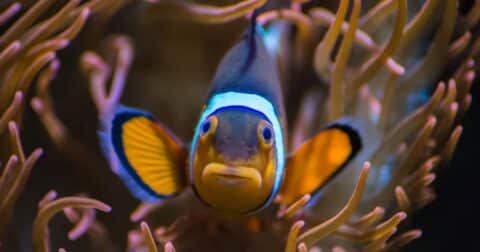Solutions
New Cow-Free Cheese May Be Tastier, but Still Faces Hurdles
Food•5 min read
Solutions
Why consumers should beware the latest humane- and green-washing tactic.


Words by Jessica Scott-Reid
A growing number of consumers want to know that their meat, dairy and eggs come from animals who were treated well. The trend has become so widespread, in fact, that in the past decade, animal welfare labels have become a familiar sight on grocery store shelves. Now, a growing number of industry and animal welfare groups say fish welfare labels are the next frontier. The once-pervasive “happy cow” marketing campaign of the early-aughts may soon find a new life with the fish industry, as we enter the era of the “happy fish.” But just as with labels for meat and dairy, the promise does not always meet the reality. In other words, there’s no reason to believe the practice described as humane-washing won’t be a problem for fish too.
Americans are saying they want to eat a lot more fish these days, citing a mix of health and environmental concerns. Just as many consumers of meat are drawn to cuts marked “sustainable,” fish shoppers too are looking for an environmental seal of approval. So much so, in fact, that the “sustainable” seafood market is predicted to reach more than $26 million by 2030.
One popular sustainability certification program for wild caught fish is the blue check from the Marine Stewardship Council (MSC), one of the oldest fish certifications, used for an estimated 15 percent of the global wild fish catch. The blue check signals to consumers that the fish “comes from healthy and sustainable fish stocks,” according to the group, meaning that the fisheries considered the environmental impact and how well the fish populations were managed to avoid overfishing. So while restricting how many fish a company harvests doesn’t address how fish die, it at least avoids wiping out entire populations.
Yet the pledge does not always match the practice. According to a 2020 analysis, researchers found that MSC blue check marketing materials often misrepresent the typical environment of the fisheries it certifies. Even though the certifying group “disproportionately features photographs of small-scale fisheries,” most of the fish certified by MSC Blue Check are “overwhelmingly from industrial fisheries.” And while around half of the group’s promotional content “featured small-scale, low-impact fishing methods,” in reality, these types of fisheries represent a mere “7 percent of the products it certified.”
In reaction to the study, the Marine Stewardship Council “raised concerns” about the authors’ connection to a group that had criticized MSC in the past. The journal conducted a post-publication editorial review and found no errors in the study’s findings, though it did revise two characterizations of the council in the article and revise the competing interest statement.
Sentient reached out to the Marine Stewardship Council to ask about what, if any, animal welfare standards the blue check promises. In an email response, Jackie Marks, senior communications and public relations manager for MSC replied that the organization is “on a mission to end overfishing,” with a focus on environmentally sustainable fishing” and “ensuring that the health of all species and habitats are protected for the future.” But, she continues, “humane harvest and animal sentience sit outside the MSC’s remit.”
Another resource for conscious consumers is the Monterey Bay Seafood Watch Guide. The online tool shows consumers which species and from which regions to “responsibly” purchase, and which ones to avoid, covering wild fisheries and aquaculture operations alike. Here too, the emphasis is on environmental sustainability: “Seafood Watch’s recommendations address the environmental impacts of seafood production to help ensure that it is fished and farmed in ways that promote the long-term well-being of wildlife and the environment,” according to its website.
Yet in Seafood Watch’s extensive standards for aquaculture, and for fisheries, (all 89 and 129 pages, respectively), standards that “promote the long-term well-being of wildlife,” neither animal welfare nor humane treatment are mentioned. For now, most fish labels with claims about sustainability primarily cover environmental practices, but a new crop of labels that investigate fish welfare are on the horizon.
Up until a few years ago, most consumers didn’t give much thought to fish, how they lived or whether they were capable of suffering. But a growing body of research has uncovered evidence of fish sentience, including that some fish recognize themselves in the mirror, and are quite capable of feeling pain.
As the public learns more about the inner lives of all sorts of animals, including fish, some consumers are willing to pay more for products that assure them the fish was treated well. Fish and seafood companies are taking notice of this, along with some labeling bodies, including the Aquaculture Stewardship Council, which has called animal welfare “a key factor in defining ‘responsible production.”
In 2022, ASC published its Fish Health and Welfare Criterion draft, where the group called for certain welfare considerations to be included, including “anesthesia of fish during handling operations that can inflict pain or injury if fish are moving,” and “maximum time fish can be out of water,” that “shall be signed off by a veterinarian.”
Much like most meat industry labels, the group leaves oversight mainly to farmers. ASC spokesperson Maria Filipa Castanheira tells Sentient that the group’s “work on Fish Health and Welfare consists of a set of indicators that allows farmers to continuously monitor and evaluate their farming systems and the status of fish species.” These are “real daily actions that take into account some key indicators defined as Operational Welfare Indicators (OWI): water quality, morphology, behavior and mortality,” she adds.
Heather Browning, PhD, a researcher and lecturer on animal welfare at the University of Southampton, raised concerns about the measures. Browning, telling industry publication The Fish Site that these measures mostly focus more on animal health than well-being.
Other measures that could address animal well-being specifically include preventing overcrowding — which is common and can lead to stress — and avoiding sensory deprivation caused by a lack of natural stimuli. Mishandling during capture or transport can also cause fish to suffer, and slaughter methods for farmed fish, also often considered by animal protection advocates to be inhumane, are overlooked by many labeling schemes.
In the U.S., “wild caught” labeled fish do tend to experience some welfare benefits as compared to farmed fish, at least during their lives.
According to Lekelia Jenkins, PhD, associate professor of sustainability at Arizona State University, who specializes in solutions for sustainable fisheries, these animals “grow up in their natural environments, are allowed to engage in the ecosystem and provide their ecological function in their natural environment.” This, she adds, “is a healthy thing for the environment and the fish up to the point of capture.” Compare this to many fish raised in industrial aquaculture operations, where overcrowding and living in tanks can cause stress and suffering.
That all takes a drastic turn for the worse, however, when fish are caught. According to a 2021 report by Eurogroup for Animals, fish can die in any number of painful ways, including “chased to exhaustion,” crushed or asphyxiated. Numerous other fish called bycatch are also caught up in nets and killed in the process, often in the same painful manner.
While regulating “humane slaughter” is notoriously difficult, a number of national welfare organizations are trying, including Australia’s RSPCA, Friends of the Sea, RSPCA Assured and Best Aquaculture Practices, by making stunning before slaughter mandatory. Advocacy group Compassion in World Farming created a table that lists the standards — and lack thereof — for a variety of fish labeling schemes, including whether the way the fish is slaughtered is humane and whether stunning prior to killing is mandatory.
CIWF tells Sentient that for the group “humane slaughter” is codified as “slaughter without suffering, which can take one of those three forms: death is instantaneous; stunning is instantaneous and death intervenes before consciousness returns; death is more gradual but is non-aversive.” It adds that “Instantaneous is interpreted by the EU as taking less than a second.”
Included on CIWF’s list is the Global Animal Partnership (GAP), which also requires stunning before slaughter, but unlike the others, also requires larger living conditions, minimized stocking densities and enrichment for farmed salmon. However, a representative from GAP tells Sentient that, for now, there are no GAP-certified salmon operations.
Still, there are other efforts, some more ambitious than others. One, the Ike Jime slaughtering method, aims to fully kill the fish in seconds, while the other, cell cultivated fish, requires no slaughter at all.
This piece has been updated to include a response from a representative from the Global Animal Partnership.